Bulbulator grass. PCB Etching Accelerator
I remember when I was 12 years old when I poisoned my first printed circuit board, I was just exhausted from impatience to make this process faster. Then the solution was old and etching lasted almost a day. Now I’m baiting, of course, much faster, but still not in a couple of minutes. But you really want to see the result of your work and move on to a more interesting stage - drilling and sealing parts. And the thought settled in my head how to speed up this process. As a matter of fact, all who etch printed circuit boards know that acceleration of etching is provided by two factors: increase in temperature of a solution and its constant mixing. The first factor is easily achievable - flooded ferric chloride with boiling water and received a profit. And for the implementation of the second, which only designs I have not seen: and mixers, and rocking, and pedals, etc. rave. But in fact, everything turned out to be much simpler, cheaper,
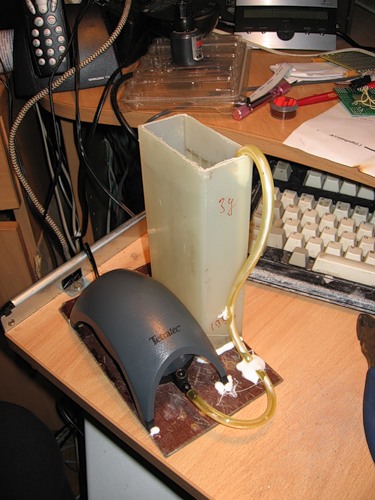
Bulbulator in person
For the manufacture you will need:
- a half-liter plastic bottle of your favorite drink;
- cheap aquarium compressor;
- a vertical rectangular container, preferably transparent (I used the capacity from an old battery, you can use a square vase, the main thing is not metal);
- a hose for the compressor, a meter long (bought in the same store as the compressor itself);
- a rectangular plate, for assembly (you can use plywood, or iron, I used a thick getinaks).
Of the tools we need only hot melt glue with a thermal gun.
First, I made a holder for printed circuit boards. Since creativity was free, and as an artist paints a picture, I began with the most interesting and simple. We cut out the holder for the printed circuit boards from the plastic bottle. Just cut the bottle in half, leaving the neck on one side, and remove the bottom on the other side. In the remaining half, we make two oval holes where the printed circuit board will be inserted. Will be clearer if we look at the picture
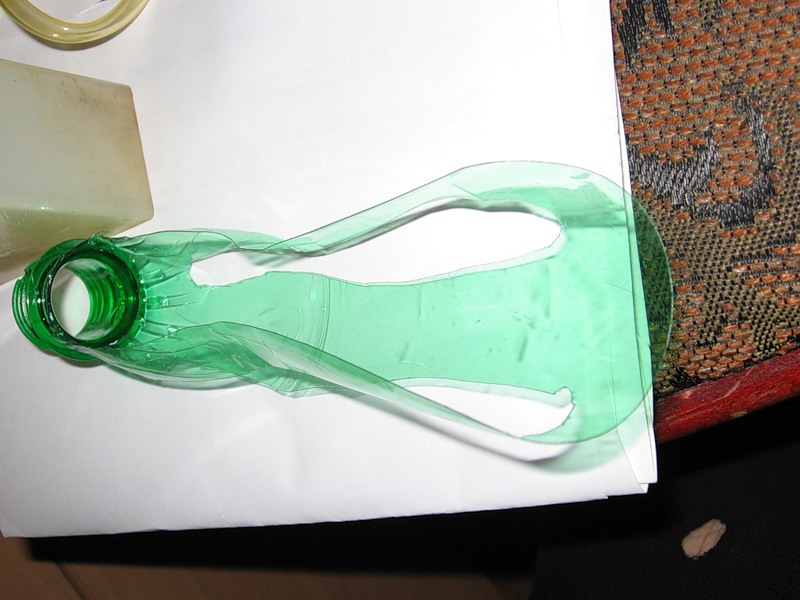
PCB holder.
After which I proceeded to manufacture the apparatus itself.
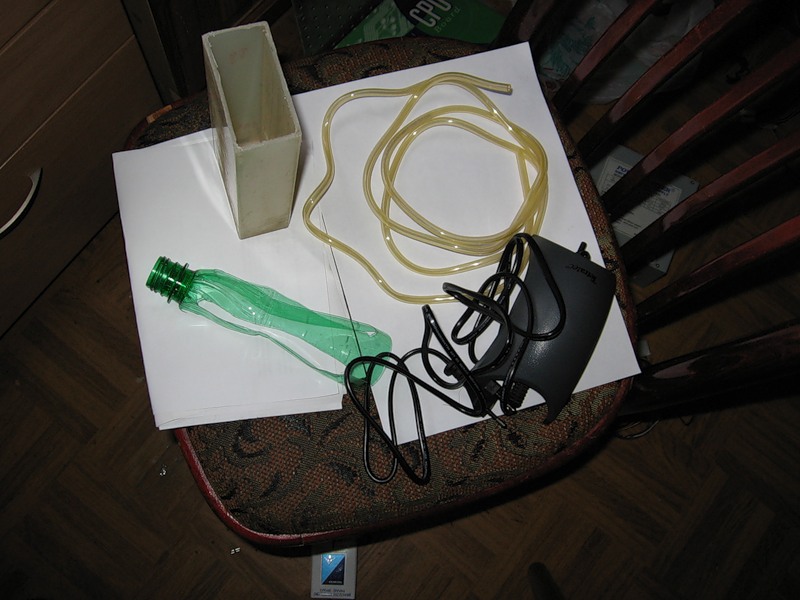
Sources: Capacity, compressor, hose, holder for printed circuit boards.
First, we cover the bottom of the getinax plate with a thin layer of hot-melt adhesive, so that during operation of the compressor our etch does not run away. We cast some kind of legs.
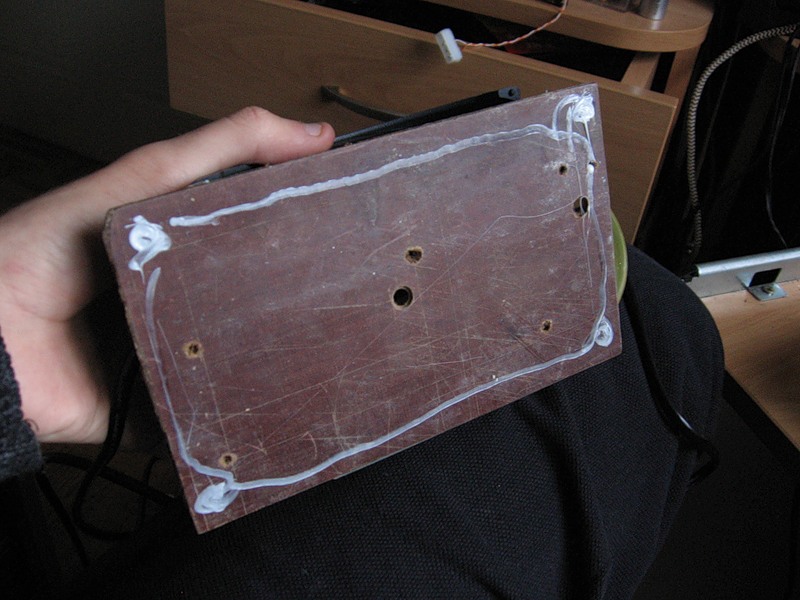
“Feet” for protection against slipping and vibration
First we place the components on the plate, figuring out their most optimal configuration. We

position the compressor and the container.
Glue the container to the getinax plate with hot-melt adhesive. Near the hot glue we make grooves for installing the compressor. You can simply stick the compressor next, but I decided to make it removable. If there are no grooves, then the compressor will run away due to vibration during operation, despite the rubber feet.
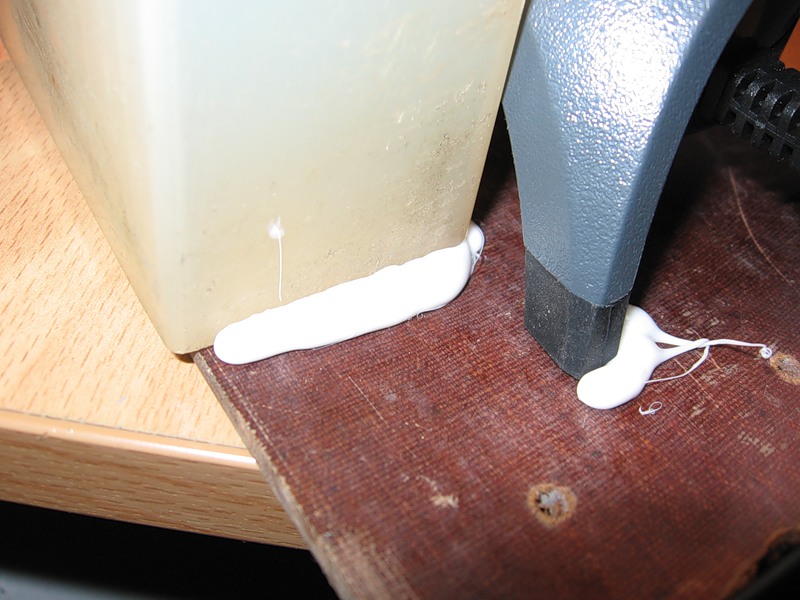
Adhered container and poured grooves for compressor
Further, if the hose is twisted, then we need to straighten it. We boil a kettle, and we go with a hot kettle and a hose to the bathroom. We pour the hose with boiling water hanging down, and it straightens. We bend the lower end of the hose at an angle, and lower it into the container. At the top in the corner we fix with hot glue.

Fasten the hose in the tank
Cut off excess hose is inserted into the compressor, and that there are no loose loops, anchoring them on the hot melt from the bottom plate and on the capacity.

Hose fastening.
Everything, the device is ready. After that, testing is natural. To begin with, you can pour some water and see how it works, the device doesn’t work anywhere.
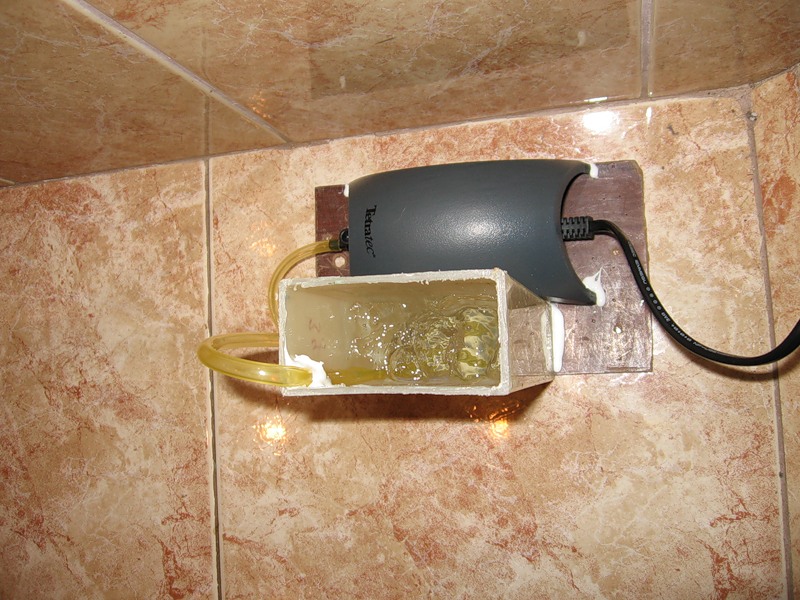
Checking the operation of the device
Pour into the capacity of ferric chloride and fill it with hot water.
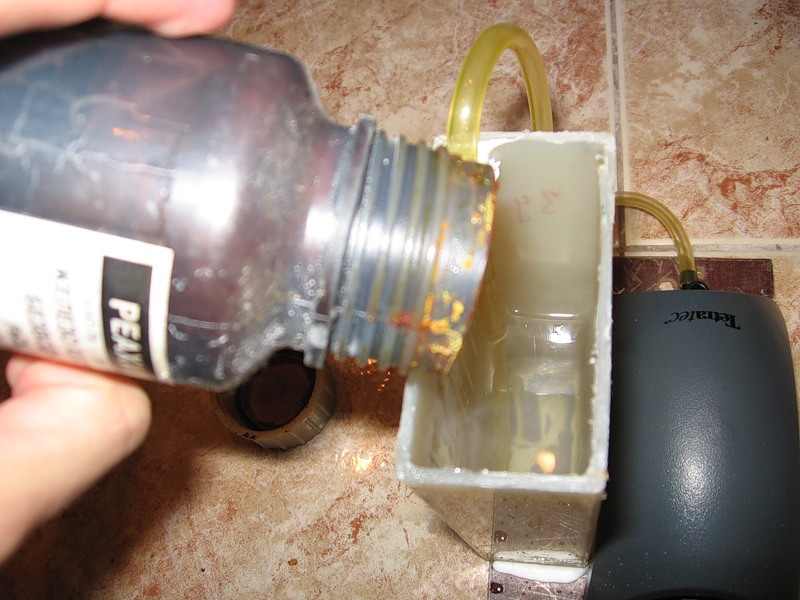
Pour in ferric chloride.
I usually pour it from the tap, it’s not so hot there and can’t melt the toner when making boards using the laser-ironing method. Then we insert the board into the holder and lower it into the solution, turn on the compressor and poison.
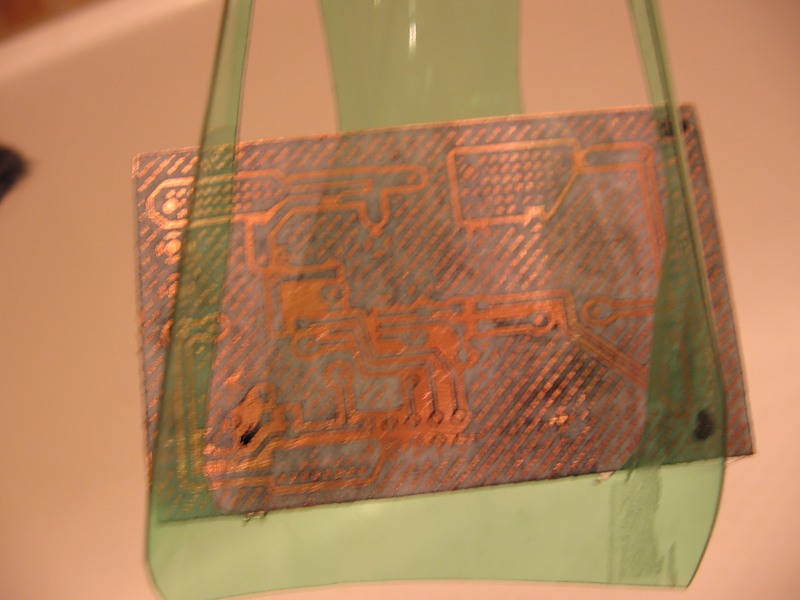
The inserted card in the taped
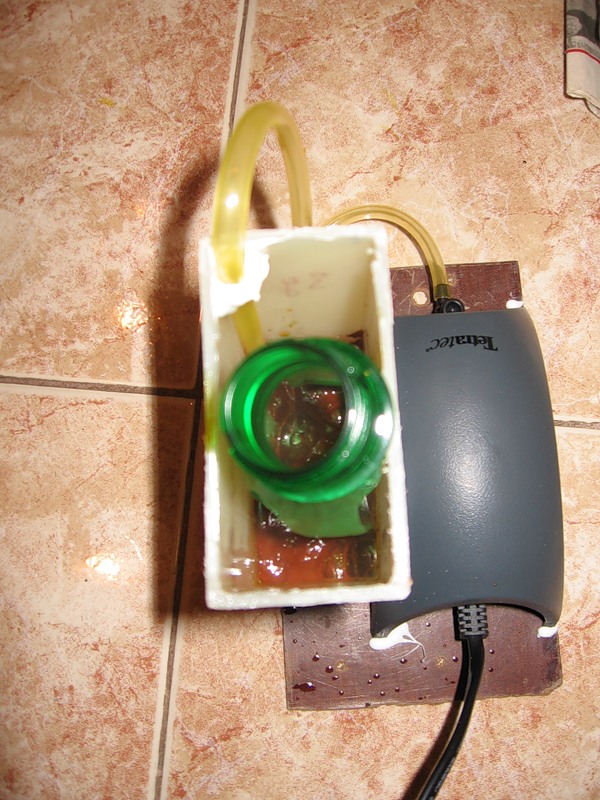
Etching
The etching process. Yes, noisy
Etching in this way takes no more than 5 minutes.
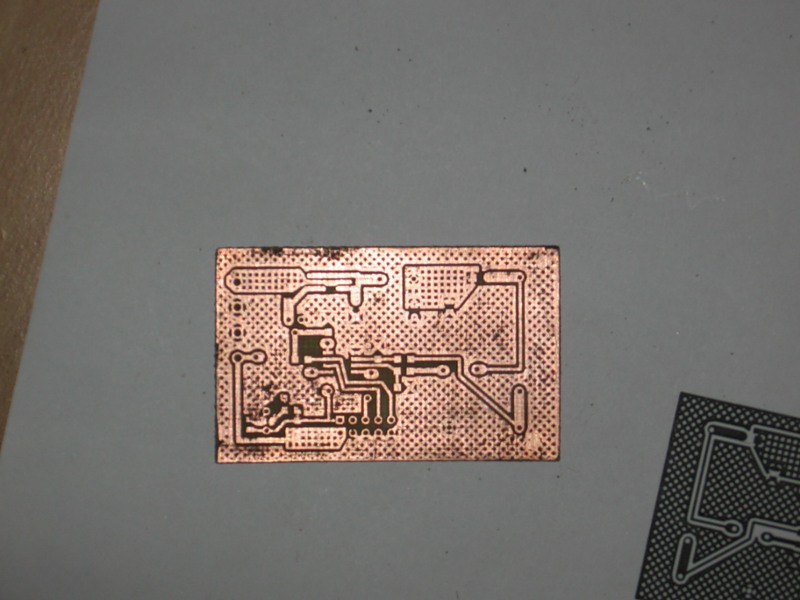
Ready etched board
A little hemorrhoids, a couple of hours of work, and the results will be on the face. The main thing is to be bolder. Looking back, I want to say that the capacity should be made as high as possible, because with such etching, this non-acid is so sprayed and then it is very difficult to wash it even from the tiles in the bathroom. Therefore, I covered the container with a rag. The second - it makes sense to think over the holder of printed circuit boards so that it does not interfere with etching and is not made of metal. Thirdly, the capacity turned out to be quite small, and is not suitable for etching more serious boards. But the positive thing is that thanks to this construct at home I produced printed circuit boards on a small-scale industrial scale.
Literature:
1. ru.wikipedia.org/wiki/Lazerno-iron_technology - technology for the manufacture of printed circuit boards using an iron and a laser printer.
2.easyelectronics.ru/proektirovanie-pechatnoj-platy-i-izgotovlenie-ustrojstva-v-eagle-cad-na-primere-pickit2.html Useful article from A to Z, how to separate and make a printed circuit board.
In fairness, it is worth noting that a similar article was once written for the journal Iron, but especially for Habr, this article is completely rewritten and is a separate work.

Bulbulator in person
For the manufacture you will need:
- a half-liter plastic bottle of your favorite drink;
- cheap aquarium compressor;
- a vertical rectangular container, preferably transparent (I used the capacity from an old battery, you can use a square vase, the main thing is not metal);
- a hose for the compressor, a meter long (bought in the same store as the compressor itself);
- a rectangular plate, for assembly (you can use plywood, or iron, I used a thick getinaks).
Of the tools we need only hot melt glue with a thermal gun.
Manufacture
First, I made a holder for printed circuit boards. Since creativity was free, and as an artist paints a picture, I began with the most interesting and simple. We cut out the holder for the printed circuit boards from the plastic bottle. Just cut the bottle in half, leaving the neck on one side, and remove the bottom on the other side. In the remaining half, we make two oval holes where the printed circuit board will be inserted. Will be clearer if we look at the picture

PCB holder.
After which I proceeded to manufacture the apparatus itself.

Sources: Capacity, compressor, hose, holder for printed circuit boards.
First, we cover the bottom of the getinax plate with a thin layer of hot-melt adhesive, so that during operation of the compressor our etch does not run away. We cast some kind of legs.

“Feet” for protection against slipping and vibration
First we place the components on the plate, figuring out their most optimal configuration. We

position the compressor and the container.
Glue the container to the getinax plate with hot-melt adhesive. Near the hot glue we make grooves for installing the compressor. You can simply stick the compressor next, but I decided to make it removable. If there are no grooves, then the compressor will run away due to vibration during operation, despite the rubber feet.

Adhered container and poured grooves for compressor
Further, if the hose is twisted, then we need to straighten it. We boil a kettle, and we go with a hot kettle and a hose to the bathroom. We pour the hose with boiling water hanging down, and it straightens. We bend the lower end of the hose at an angle, and lower it into the container. At the top in the corner we fix with hot glue.

Fasten the hose in the tank
Cut off excess hose is inserted into the compressor, and that there are no loose loops, anchoring them on the hot melt from the bottom plate and on the capacity.

Hose fastening.
Everything, the device is ready. After that, testing is natural. To begin with, you can pour some water and see how it works, the device doesn’t work anywhere.

Checking the operation of the device
Pour into the capacity of ferric chloride and fill it with hot water.

Pour in ferric chloride.
I usually pour it from the tap, it’s not so hot there and can’t melt the toner when making boards using the laser-ironing method. Then we insert the board into the holder and lower it into the solution, turn on the compressor and poison.

The inserted card in the taped

Etching
The etching process. Yes, noisy
Etching in this way takes no more than 5 minutes.

Ready etched board
Summary
A little hemorrhoids, a couple of hours of work, and the results will be on the face. The main thing is to be bolder. Looking back, I want to say that the capacity should be made as high as possible, because with such etching, this non-acid is so sprayed and then it is very difficult to wash it even from the tiles in the bathroom. Therefore, I covered the container with a rag. The second - it makes sense to think over the holder of printed circuit boards so that it does not interfere with etching and is not made of metal. Thirdly, the capacity turned out to be quite small, and is not suitable for etching more serious boards. But the positive thing is that thanks to this construct at home I produced printed circuit boards on a small-scale industrial scale.
Literature:
1. ru.wikipedia.org/wiki/Lazerno-iron_technology - technology for the manufacture of printed circuit boards using an iron and a laser printer.
2.easyelectronics.ru/proektirovanie-pechatnoj-platy-i-izgotovlenie-ustrojstva-v-eagle-cad-na-primere-pickit2.html Useful article from A to Z, how to separate and make a printed circuit board.
In fairness, it is worth noting that a similar article was once written for the journal Iron, but especially for Habr, this article is completely rewritten and is a separate work.
